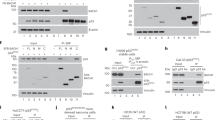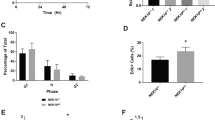Abstract
Mutations of the BRCA1 tumor suppressor gene are the most commonly detected alterations in familial breast and ovarian cancer. Although BRCA1 is required for normal mouse development, the molecular basis for its tumor suppressive function remains poorly understood. We show here that BRCA1 increases p53-dependent transcription from the p21WAF1/CIP1 and bax promoters. We also show that BRCA1 and p53 proteins interact both in vitro and in vivo. The interacting regions map, in vitro, to aa 224–500 of BRCA1 and the C-terminal domain of p53. Tumor-derived transactivation-deficient BRCA1 mutants are defective in co-activation of p53-dependent transcription and a truncation mutant of BRCA1 that retains the p53-interacting region acts as a dominant inhibitor of p53-dependent transcription. BRCA1 and p53 cooperatively induce apoptosis of cancer cells. The results indicate that BRCA1 and p53 may coordinately regulate gene expression in their role as tumor suppressors.
This is a preview of subscription content, access via your institution
Access options
Subscribe to this journal
Receive 50 print issues and online access
$259.00 per year
only $5.18 per issue
Buy this article
- Purchase on Springer Link
- Instant access to full article PDF
Prices may be subject to local taxes which are calculated during checkout
Similar content being viewed by others
Author information
Authors and Affiliations
Rights and permissions
About this article
Cite this article
Zhang, H., Somasundaram, K., Peng, Y. et al. BRCA1 physically associates with p53 and stimulates its transcriptional activity. Oncogene 16, 1713–1721 (1998). https://doi.org/10.1038/sj.onc.1201932
Received:
Accepted:
Published:
Issue Date:
DOI: https://doi.org/10.1038/sj.onc.1201932
Keywords
This article is cited by
-
A BRCA2 germline mutation and high expression of immune checkpoints in a TNBC patient
Cell Death Discovery (2023)
-
Targeting AKT with costunolide suppresses the growth of colorectal cancer cells and induces apoptosis in vitro and in vivo
Journal of Experimental & Clinical Cancer Research (2021)
-
RBCK1 promotes p53 degradation via ubiquitination in renal cell carcinoma
Cell Death & Disease (2019)
-
BRCA-1 depletion impairs pro-inflammatory polarization and activation of RAW 264.7 macrophages in a NF-κB-dependent mechanism
Molecular and Cellular Biochemistry (2019)
-
BRCA1 gene: function and deficiency
International Journal of Clinical Oncology (2018)



